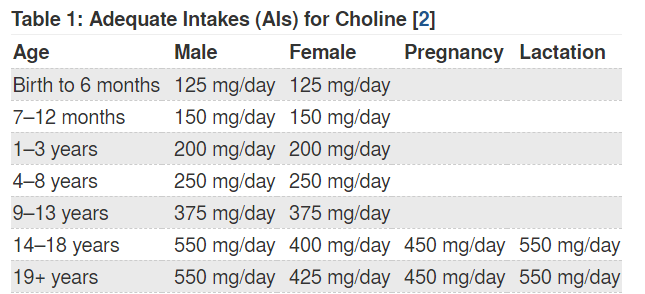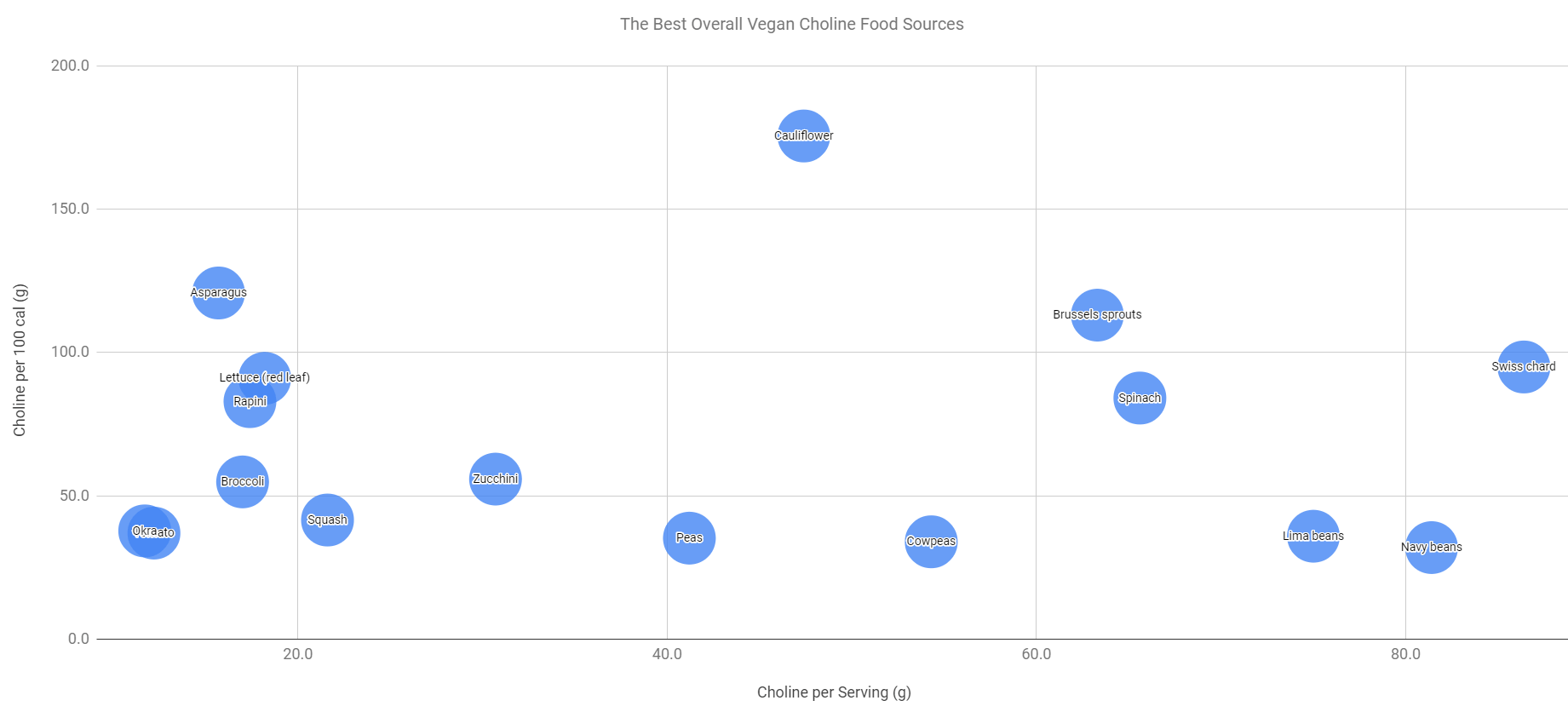Choline is an essential nutrient that vegans can have trouble getting.
The absolute best sources of choline are animal products (meat, fish, dairy, etc.).
To help fellow vegans out, I compiled a list of the best vegan food sources of choline.
Keep in mind that if you buy any packaged foods like cereal, they may be fortified with choline as well.
Table of Contents
How Much Choline Do You Need?
According to the NIH, adult men need 550 mg per day, while adult women need at least 425 mg.

Choline is water soluble, so it typically doesn’t hurt to get a bit more than the adequate intake.
However, getting more than 3,500 mg for an adult has been linked with a variety of symptoms including liver toxicity, excessive sweating, and vomiting.
The Best Vegan Food Sources of Choline
You’ll notice that no one serving of any food will get you past the RDA. You’re going to have to combine multiple foods on a regular basis.
| Food | Choline (mg) per 100 grams | Choline (mg) per 100 calories |
|---|---|---|
| Flaxseed | 78.6 | 14.7 |
| Seaweed (dried) | 65.7 | 23.0 |
| Cashew | 61.0 | 10.6 |
| Pine nuts | 55.9 | 8.3 |
| Buckwheat groats | 54.2 | 15.7 |
| Peanuts | 52.5 | 9.3 |
| Almonds | 52.0 | 9.0 |
| Hazelnut | 45.6 | 7.3 |
| Navy beans | 44.7 | 31.9 |
| Cauliflower | 44.3 | 175.6 |
| Lima beans | 44.1 | 35.9 |
| Chickpeas | 42.8 | 26.1 |
| Brussels sprouts | 40.6 | 113.0 |
| Pecans | 40.4 | 5.8 |
| Walnut | 39.1 | 6.0 |
| Cowpeas | 32.9 | 33.9 |
| Lentils | 32.7 | 28.1 |
| Black beans | 32.6 | 24.7 |
| Wheat flour (whole-grain) | 31.2 | 9.4 |
| Fava bean | 30.6 | 27.8 |
| Kidney beans | 30.5 | 24.0 |
| Rye grain | 30.4 | 9.0 |
| Ginger | 30.0 | 30.0 |
| Mung bean | 29.4 | 28.0 |
| Brazil nut | 28.9 | 4.4 |
| Peas | 28.4 | 35.2 |
| Asparagus | 26.2 | 120.8 |
| Sesame seeds | 25.6 | 4.5 |
| Cassava | 23.7 | 14.8 |
| Garlic | 23.3 | 17.5 |
| Corn | 23.0 | 26.7 |
| Quinoa | 23.0 | 19.1 |
| Spinach | 19.3 | 84.1 |
| Broccoli | 18.7 | 54.8 |
| Rapini | 18.3 | 82.9 |
| Swiss chard | 18.0 | 94.9 |
| Green bean | 15.3 | 49.4 |
| Avocado | 14.2 | 8.5 |
| Plantain | 13.5 | 11.1 |
| Barley | 13.4 | 10.9 |
| Okra | 12.3 | 37.7 |
| Sweet potato | 12.3 | 14.3 |
| Raspberry | 12.1 | 23.0 |
| Coconut meat | 12.1 | 3.4 |
| Lettuce (red leaf) | 11.8 | 91.0 |
| White potato | 11.0 | 15.9 |
| Cabbage | 10.7 | 43.2 |
| Tangerine | 10.2 | 19.1 |
| Olive | 10.0 | 8.4 |
| Date | 9.9 | 3.6 |
| Banana | 9.8 | 11.0 |
| Leek | 9.6 | 15.7 |
| Zucchini | 9.5 | 55.8 |
| Watercress | 8.8 | 73.3 |
| Carrot | 8.8 | 21.0 |
| Blackberry | 8.5 | 19.7 |
| Orange | 8.4 | 18.4 |
| Cantaloupe | 7.6 | 22.3 |
| Guava | 7.6 | 11.4 |
| Melon | 7.6 | 21.1 |
| Mango | 7.6 | 12.6 |
| Lychee | 7.1 | 10.6 |
| Eggplant | 6.9 | 27.6 |
| Tomato | 6.7 | 37.0 |
| Squash | 6.7 | 41.5 |
| Radish | 6.7 | 40.0 |
| Bok choy | 6.4 | 50.0 |
| Beets | 6.3 | 14.3 |
| Nectarine | 6.2 | 14.1 |
| Peach | 6.1 | 15.9 |
| Onion | 6.1 | 15.3 |
| Celery | 6.1 | 43.3 |
| Cherry | 6.1 | 9.7 |
| Cucumber | 6.0 | 39.1 |
| Strawberry | 5.7 | 17.9 |
| Red bell pepper | 5.6 | 21.4 |
| Grapes | 5.5 | 7.9 |
| Cranberry | 5.5 | 12.0 |
| Green bell pepper | 5.5 | 27.3 |
| Pineapple | 5.5 | 11.0 |
| Lemon | 5.2 | 17.6 |
| Pear | 5.1 | 9.0 |
| Lime | 5.1 | 17.0 |
| Fig | 4.7 | 6.3 |
| Apple | 3.4 | 6.6 |
| Apricot | 2.8 | 5.8 |
| Rice | 2.1 | 1.6 |
| Plum | 2.0 | 4.3 |
| Chestnut | 1.5 | 0.6 |
| Mustard greens | 0.5 | 2.0 |
| Kale | 0.5 | 1.3 |
- Nuts – Nuts make up most of the top spots on the table above per 100 grams. Cashews, peanuts, almonds, and other nuts all have a lot of choline. However, they also have a lot of calories, so it’s unlikely that you’ll be able to get your RDA of choline from nuts alone.
- Legumes – Overall, legumes are a great sources of choline. Just about every type of bean and lentil is near the top of the list.
- Green vegetables – There’s also quite a few vegetables like spinach, chard, and brussels sprouts that are relatively high in choline.
- Certain grains – Specific types of grain (buckwheat and rye) also have a high amount of choline.
The Best OVERALL Choline Sources for Vegans
There’s one last way we can look at choline sources, by comparing the amount of choline per serving and per 100 calories at the same time.
Below is a bubble chart that does this. The best sources should rank well on both axis, meaning the very best ones will be close to the top-right of the chart.
Click the chart to see the full-sized version.
 None hit that top-right corner.
None hit that top-right corner.
In terms of overall balance, brussel sprouts and spinach come the closest and are the best “overall” sources of choline.
Other than that, we see the other foods that topped the 2 main lists we looked at above:
- Cauliflower
- Swiss chard
- Lima beans
- Navy beans
Stick to these if you’re trying to get the most choline possible, with the least amount of servings and calories.
What is Choline Used For?
While choline technically can be made in the body, it can only be made in very small amounts. The majority of your choline must come from foods.
A significant deficit in choline can lead to liver and muscle damage, and an increase of an amino acid called homocysteine. Homocysteine is associated with heart disease, heart attacks, and more.
In short, it’s pretty important that you get enough choline from your diet on a regular basis.

Are these choline counts for cooked or raw veggies? I’m assuming brussel sprouts are cooked. But what about spinach, broccoli and cauliflower? I try not to eat raw broccoli or cauliflower because I don’t care for them raw. But I eat raw spinach daily.
Most (if not all) the data for vegetables here is for them raw (including spinach, broccoli, and cauliflower), that’s just the most available data in the USDA’s food database.
You can search for particular vegetables yourself and try to find them cooked if you’d like.
I’ve been trying to understand this. Not a good idea to get choline from animal sources as it is involved in coronary heart disease. https://www.nejm.org/doi/full/10.1056/NEJMoa1109400?query=featured_home